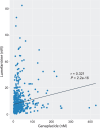Ex vivo susceptibilities to ganaplacide and diversity in potential resistance mediators in Ugandan Plasmodium falciparum isolates
- PMID: 39136468
- PMCID: PMC11373204
- DOI: 10.1128/aac.00466-24
Ex vivo susceptibilities to ganaplacide and diversity in potential resistance mediators in Ugandan Plasmodium falciparum isolates
Abstract
Novel antimalarials are urgently needed to combat rising resistance to available drugs. The imidazolopiperazine ganaplacide is a promising drug candidate, but decreased susceptibility of laboratory strains has been linked to polymorphisms in the Plasmodium falciparum cyclic amine resistance locus (PfCARL), acetyl-CoA transporter (PfACT), and UDP-galactose transporter (PfUGT). To characterize parasites causing disease in Africa, we assessed ex vivo drug susceptibilities to ganaplacide in 750 P. falciparum isolates collected in Uganda from 2017 to 2023. Drug susceptibilities were assessed using a 72-hour SYBR Green growth inhibition assay. The median IC50 for ganaplacide was 13.8 nM, but some isolates had up to 31-fold higher IC50s (31/750 with IC50 > 100 nM). To assess genotype-phenotype associations, we sequenced genes potentially mediating altered ganaplacide susceptibility in the isolates using molecular inversion probe and dideoxy sequencing methods. PfCARL was highly polymorphic, with eight mutations present in >5% of isolates. None of these eight mutations had previously been selected in laboratory strains with in vitro drug pressure and none were found to be significantly associated with decreased ganaplacide susceptibility. Mutations in PfACT and PfUGT were found in ≤5% of isolates, except for two frequent (>20%) mutations in PfACT; one mutation in PfACT (I140V) was associated with a modest decrease in susceptibility. Overall, Ugandan P. falciparum isolates were mostly highly susceptible to ganaplacide. Known resistance mediators were polymorphic, but mutations previously selected with in vitro drug pressure were not seen, and mutations identified in the Ugandan isolates were generally not associated with decreased ganaplacide susceptibility.
Keywords: PfACT; PfCARL; PfUGT; Plasmodium falciparum; antimalarial drugs; drug susceptibility; ganaplacide; malaria.
Conflict of interest statement
Benjamin Blasco, Maelle Duffey, and Melanie Rouillier were employed by MMV, who funded part of the study.
Figures



Similar articles
-
Susceptibility of Ugandan Plasmodium falciparum Isolates to the Antimalarial Drug Pipeline.Microbiol Spectr. 2023 Jun 15;11(3):e0523622. doi: 10.1128/spectrum.05236-22. Epub 2023 May 9. Microbiol Spectr. 2023. PMID: 37158739 Free PMC article.
-
Low polymorphisms in pfact, pfugt and pfcarl genes in African Plasmodium falciparum isolates and absence of association with susceptibility to common anti-malarial drugs.Malar J. 2019 Aug 28;18(1):293. doi: 10.1186/s12936-019-2919-3. Malar J. 2019. PMID: 31455301 Free PMC article.
-
Associations between Varied Susceptibilities to PfATP4 Inhibitors and Genotypes in Ugandan Plasmodium falciparum Isolates.Antimicrob Agents Chemother. 2021 Sep 17;65(10):e0077121. doi: 10.1128/AAC.00771-21. Epub 2021 Aug 2. Antimicrob Agents Chemother. 2021. PMID: 34339273 Free PMC article.
-
Prevalence of mutations in the Plasmodium falciparum chloroquine resistance transporter, PfCRT, and association with ex vivo susceptibility to common anti-malarial drugs against African Plasmodium falciparum isolates.Malar J. 2020 Jun 5;19(1):201. doi: 10.1186/s12936-020-03281-x. Malar J. 2020. PMID: 32503540 Free PMC article.
-
Plasmodium vivax and Plasmodium falciparum ex vivo susceptibility to anti-malarials and gene characterization in Rondônia, West Amazon, Brazil.Malar J. 2014 Feb 28;13:73. doi: 10.1186/1475-2875-13-73. Malar J. 2014. PMID: 24581308 Free PMC article.
References
-
- World Health Organization . 2023. World malaria report 2023. Geneva: World Health Organization
-
- Dondorp AM, Nosten F, Yi P, Das D, Phyo AP, Tarning J, Lwin KM, Ariey F, Hanpithakpong W, Lee SJ, Ringwald P, Silamut K, Imwong M, Chotivanich K, Lim P, Herdman T, An SS, Yeung S, Singhasivanon P, Day NPJ, Lindegardh N, Socheat D, White NJ. 2009. Artemisinin resistance in Plasmodium falciparum malaria. N Engl J Med 361:455–467. doi:10.1056/NEJMoa0808859 - DOI - PMC - PubMed
-
- Uwimana A, Umulisa N, Venkatesan M, Svigel SS, Zhou Z, Munyaneza T, Habimana RM, Rucogoza A, Moriarty LF, Sandford R, et al. . 2021. Association of Plasmodium falciparum kelch13 R561H genotypes with delayed parasite clearance in Rwanda: an open-label, single-arm, multicentre, therapeutic efficacy study. Lancet Infect Dis 21:1120–1128. doi:10.1016/S1473-3099(21)00142-0 - DOI - PMC - PubMed
-
- Asua V, Conrad MD, Aydemir O, Duvalsaint M, Legac J, Duarte E, Tumwebaze P, Chin DM, Cooper RA, Yeka A, Kamya MR, Dorsey G, Nsobya SL, Bailey J, Rosenthal PJ. 2021. Changing prevalence of potential mediators of aminoquinoline, antifolate, and artemisinin resistance across Uganda. J Infect Dis 223:985–994. doi:10.1093/infdis/jiaa687 - DOI - PMC - PubMed

